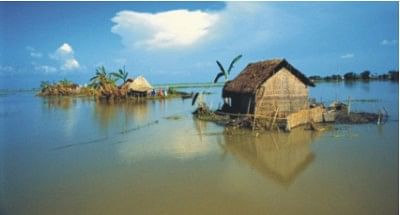Dhaka's vulnerability to climate change

PHOTO: COURTESY
Take one of the most unplanned urban centres in the world, wedge it between four flood-prone rivers in the most densely packed nation in Asia, then squeeze it between the Himalaya mountain range and a body of water that not only generates violent cyclones and the occasional tsunami, but also creeps further inland every year, washing away farmland, tainting drinking water, submerging fertile deltas, and displacing villagers as it approaches -- and there you have it: Dhaka, the capital of Bangladesh and one of the world's largest mega cities.
Add the expected impact of climate change to this cauldron and it's a recipe for disaster. Experts believe that the melting of glaciers and snow in the Himalayas, along with increasing rainfall attributable to climate change, will lead to more flooding in Bangladesh in general, especially in cities located near the coast and in the delta region, including Dhaka.
The capital may also experience increased temperatures from rising levels of vehicle exhaust emissions, increased industrial activities and increased use of air conditioning.
Researchers, studying the impact of climate change on Dhaka, predict that the city will be affected in two major ways: Floods and drainage congestion, and heat stress.
The elevation in Dhaka ranges between 2 and 13 metres above sea level, which means that even a slight rise in the sea level is likely to engulf large parts of the city.
Moreover, high urban growth rates and high urban densities have already made Dhaka more susceptible to human-induced environmental disasters. With an urban growth rate of more than 4% annually, Dhaka, which already hosts more than 13 million people, is one of the fastest growing cities in Southern Asia, and is projected to accommodate more than 20 million by 2025.
The sheer number of people living in the city means that the negative consequences of climate change are likely to be felt by a large number of people, especially the urban poor who live in flood-prone and water-logged areas.
A recent mapping and census of slums conducted by the Centre for Urban Studies in Dhaka shows that nearly 60% of the slums in the city have poor or no drainage and are prone to frequent flooding. The problems associated with flooding are compounded by poor quality housing and overcrowding.
The survey found that more than one-third of Dhaka's population lived in housing where almost all the structures were too weak to withstand large-scale environmental disasters.
Although Bangladesh has among the highest population densities in the world (at 2,600 persons per square mile), the population density in slums is roughly 200 times greater an astounding figure, considering that nearly all slums are dominated by single-storey structures.
Approximately 80% of the slum population in Dhaka live in dense slum clusters of between 500 and 1,500 persons per acre. Overcrowding is extremely prevalent; more than 90% of slum dwellers share a single room with three or more people.
Floods in dense, poorly serviced settlements can lead to other hazards, which have a significant impact on the health of urban poor residents. Floodwaters in slums can mix with raw sewage and breed water-borne diseases, such as diarrhoea, typhoid and scabies. Water supply too gets contaminated during floods, as pipes in slum areas are likely to be damaged or to leak.
Climate experts generally agree that apart from taking active steps to reduce the possibility of global climate change itself, cities can take steps to prevent the harmful aspects of natural disasters by improving planning, putting in effective infrastructure and establishing disaster preparedness.
Plans for flood protection are already underway in greater Dhaka; the government, as result of frequent flooding in the 1980s, has already completed construction of embankments, concrete reinforced walls and pumping stations in the densest part of the city.
Technical solutions are possible, but these solutions must also take into consideration unresolved development problems, such as the city's growing slum population, which has doubled in the last decade, and which shows no signs of abating.

 For all latest news, follow The Daily Star's Google News channel.
For all latest news, follow The Daily Star's Google News channel. 



Comments